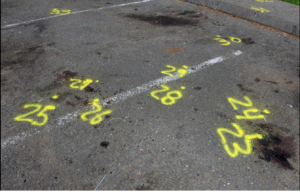Sep 25
Beyond A Reasonable Doubt
A year ago I was selected to serve as a juror on a murder trial. As a citizen of the United States, I take seriously the responsibilities of juror, but took for granted its importance until I served this significant, and yet, often dreaded role. Because of my service, the words BEYOND A REASONABLE DOUBT will forever change the way I look at the world.
Since my work is focused on mindset and resourcefulness, I stay away from the daily news, which tends to be filled with doom and gloom. As a result I had no idea I was selected to serve on a gang related murder trial that was an important win for the local police and politicians. I went into the process totally naive.
There were 15 jurors selected including the three alternates. Our careers included coach, firefighter, marketing director, nurse, psychologist, and teacher to name a few. By day two, we were bringing in snacks to share and eating lunches together. We were reasonable adults; confident we could work together to make the right decision based on the evidence presented.
The atmosphere was intimidating as we walked toward the court room through the halls filled with the defendant’s family and friends. The trial took place over six days; we heard from 20 witnesses and were presented with more than 200 pieces of evidence. The prosecutor was smart, experienced, and precise in his presentation. The defense attorney was unclear, bumbled around with questioning and appeared to have little experience in the court room. The judge was fair, even-tempered and extremely helpful in clarifying information for us jurors. I felt, and some other jurors agreed, it was the state attorney’s case to lose until he said, “the defense rests its case.”
I remember going back to the deliberation room thinking, “what, that’s it?” There was so much evidence BUT it was incomplete. It was clear one person died and seven had been wounded. It was clear the police had accounted for all the bullets; they knew what shots came from which guns, they knew which bullets went through which car, which bullets went through buildings and which merely landed on the ground. The prosecutor proved there were two shooters and a driver in the getaway car. He proved the getaway car was a rental car. He proved there were temporary cell phones used. He proved the defendant was a member of the gang. He proved there was a riff between the defendant’s gang and a neighboring gang. He proved the neighboring gang was in the parking lot the night of the shooting. The problem was he neglected to prove “BEYOND A REASONABLE DOUBT” that the defendant was there.
The state’s attorney rested his case on two eye-witnesses. The first, a young woman who told the police one story the night of the shooting, and the dramatically changed her testimony after the State of CT offered assistance to move her and her family out of the projects to another state. The second eye-witness was the alleged driver of the gateway car who was offered reduced sentencing for another crime if he testified in this case.
Regardless of their reasons for testifying, our job as jurors was to determine if the testimony matched the evidence. We re-listened to the testimony, shared our notes and reviewed pictures of the crime scene. At the start of deliberations we decided to see where we stood if we had to submit a verdict right then, and we allowed undecided as a choice because it was early in the deliberations. The verdict was totally divided. There were two of us very strong on our stance and on the opposite sides of the verdict. I argued innocence and brought the group back to the physical evidence. She argued guilty and focused on eye-witness testimony.
After 1-1/2 days of deliberations, we sent the judge a note saying we could not come to an unanimous decision and we asked for his advice. He said it was too early to say a jury could not come to a decision and instructed us to continue deliberations. Our jury foreman concluded this judge would not let us go without a guilty or innocent verdict and was pushing hard for us come to a decision. So we went back through all the materials presented, our notes and additional material we discussed as a group.
On the fourth day of deliberations, mapping out testimony on a blackboard and pouring through evidence (for a trial that took six days to present) we remained deadlocked. However, when we voted again still allowing “undecided” I was the only juror with an innocent verdict. What happened? How had the others changed their mind? During deliberations people shared compelling personal perspective. It became difficult to separate the facts of the case with testimony that didn’t match the physical evidence. A man died and it wasn’t fair someone wasn’t going to be held responsible for his death.
In truth, the most challenging part of this case was the defendant’s history of drug dealing arrests (and a conviction we wouldn’t learn about until the end of the trial). Was it likely the defendant was at the scene of the crime? Yes. Was it likely the defendant fired a gun the night of the shooting? Yes. However there was no physical evidence or testimony that could prove it BEYOND A REASONABLE DOUBT.
Once again we went out to the judge with a deadlock verdict. Once again the judge advised us to continue deliberations and went even further to urge those jurors in the minority to seriously consider the opinions of those jurors in the majority. He handed us written instructions from the 1881 Ansonia case State v. Smith advising the same and sent us back to the deliberation room.
I was personally challenged by the judge’s advice. Maybe we hadn’t deliberated long enough and needed to go through the evidence the first time, but now we had deliberated longer (hour for hour) than the two sides had spent presenting their case! It was as if in the eyes of the court “deadlocked” didn’t count as a decision when clearly it was our decision. The jury foreman repeated his feelings from a couple days earlier, “this judge is not going to let us leave if we don’t come to a verdict.”
Deliberations continued as we spent more time discussing the facts and evaluating the testimony. We voted again, this time removing the undecided option and the verdict changed again; it was now ten innocent and two guilty. Removing “undecided” had forced people to come to a decision. The two remaining guilty jurors were the woman who felt the defendant was guilty from the beginning of deliberations and another quieter juror who believed firmly in the testimony of the witness.
I watched the social pressure to make a decision dramatically influence members of the jury especially the two remaining guilty verdicts. There was pressure from the judge to come to a unanimous verdict, pressure from our jury foreman reminding us the judge won’t let us go if we don’t come to a unanimous decision and most influentially the unstated pressure that exists when you are the minority of a small group of people you respect. We asked to be dismissed for the day.
The next morning the strongest voice for a guilty verdict joined the majority. She wrote a statement she read to us to present her changed position. She had justified her agreement and felt good about her decision. The final outstanding juror reviewed his notes while we waited. He went to lunch alone. We asked questions to help him clarify his feelings. We gave him time and ended another day. On the sixth day of deliberation the final juror conceded to a not-guilty verdict.
In the end I believe it was the right decision in this case, however I don’t think it was an accurate verdict for our group of jurors. The police in attendance the day of the verdict were visibly upset with the outcome. The mayor had been elected on a stance he made the day after this shooting. We were escorted out of the court house by an armed guard and confronted at the door by the media. I was glad it was over, knowing I was changed and not yet knowing how or what to do with it.
I share my experience now because this idea of BEYOND A REASONABLE DOUBT has altered my thinking about the world in two ways:
- I look for opportunities to ask “is it true beyond a reasonable doubt?” It gives me a way to explore alternatives. It allows me to create doubt where there is certainty that doesn’t serve me. It forces me to check my story about a person or situation.
- It also brings to light the gift and responsibility of knowing when there is reasonable doubt there is a place for influence. It’s important for me to be mindful of the influence I have over others and the influence others have over me especially when I’m in doubt. I have to be mindful of the unintentional social pressures that exist and focus on clarity in my world.
 Laura Treonze, serves as Chief Life Strategist with LMT Consulting, which helps executives and teams create massive success through self-awareness. Her life-changing approach has transformed individuals and families and has redefined the way non-profits and corporations “do” business.
Laura Treonze, serves as Chief Life Strategist with LMT Consulting, which helps executives and teams create massive success through self-awareness. Her life-changing approach has transformed individuals and families and has redefined the way non-profits and corporations “do” business.
